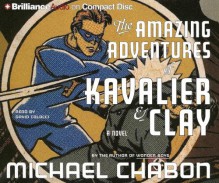Like the comic books that animate and inspire it, The Amazing Adventures of Kavalier & Clay is both larger than life and of it too. Complete with golems and magic and miraculous escapes and evil nemeses, even hand-to-hand Antarctic battle, it pursues the most important questions of love and war,...
show more
Like the comic books that animate and inspire it, The Amazing Adventures of Kavalier & Clay is both larger than life and of it too. Complete with golems and magic and miraculous escapes and evil nemeses, even hand-to-hand Antarctic battle, it pursues the most important questions of love and war, dreams and art, across pages lurid with longing and hope. Samuel Klayman--self-described little man, city boy and Jew--first meets Josef Kavalier when his mother shoves him aside in his own bed, telling him to make room for their cousin, a refugee from Nazi-occupied Prague. It's the beginning, however unlikely, of a beautiful friendship. In short order, Sam's talent for pulp plotting meets Joe's faultless, academy-trained line, and a comic-book superhero is born. A sort of lantern-jawed equaliser clad in dark blue long underwear, the Escapist "roams the globe, performing amazing feats and coming to the aid of those who languish in tyranny's chains". Before they know it, Kavalier and Clay (as Sam Klayman has come to be known) find themselves at the epicentre of comics' golden age. Suffice to say, Michael Chabon writes novels like the Escapist busts locks. Previous books such as The Mysteries of Pittsburgh and Wonder Boys have prose of equal shimmer and wit, and yet here he seems to have finally found a canvas big enough for his gifts. The whole enterprise seems animated by love: for his alternately deluded, damaged and painfully sincere characters; for the quirks and curious innocence of tough-talking wartime New York; and, above all, for comics themselves, "the inspirations and lucubrations of five hundred ageing boys dreaming as hard as they could". Far from negating such pleasures, the Holocaust's presence in the novel only makes them more pressing. Art, if not capable of actually fighting evil, can at least offer a gesture of defiance and hope--a way out of a world gone completely mad. --Mary Park, Amazon.com
show less






 6 years ago
6 years ago




 10 years ago
10 years ago